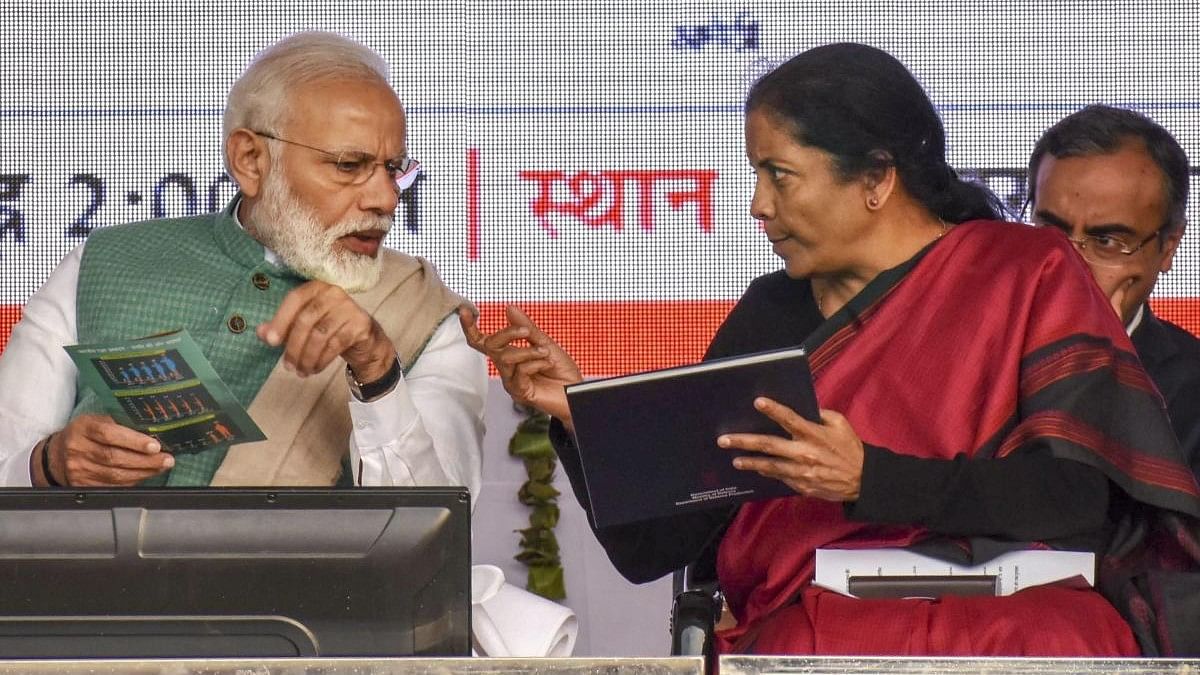
PM Narendra Modi with Finance Minister Nirmala Sitharaman.
Credit: PTI File Photo
The XVI Finance Commission (FC) has been constituted and we are in the middle of the XV FC recommendations. The financial architecture woven around cities under the XV FC has started shaking India’s urban landscape. Though the total outlay for the five-year period from 2021 to 2026 for both the urban and rural local governments at Rs 4,36,361 crore is higher than the XIV FC outlay (Rs 2,87,436 crore), the intergovernmental transfers continue to plague these local bodies, particularly the city governments.
A legitimate fear of many city governments across India is that of not meeting two of the many qualifications set in the FC and thus losing grants. City administrations and state governments should collaboratively prepare a memorandum in this regard to the Union government demanding that the norms be relaxed.
Two conditions
The first one in the XV FC is to increase property tax commensurate to the increase in the state’s GDP. This is worrisome, because a cursory look at the property tax collections exhibits that this is nowhere near the desired results, even if there is a rise in property tax collections. This fallacious condition should be dropped.
The second condition states that, “for urban local bodies, an additional entry level condition for receiving grants is the notification of minimum floor rates of property taxes by the relevant State followed by consistent improvement in the collection of property taxes in tandem with the growth rate of State's own gross state domestic product.”
Some of the states are increasing municipal boundaries and have even awarded concessions of relaxing property tax for some periods: an example is Dharamshala in Himachal Pradesh. How can property tax be implemented in such towns/cities? The Himalayan towns will be the worst affected if these two conditions are implemented.
There is another major flaw in such an understanding regarding floor area rates to be specified by the state governments. This is a violation of the 74th constitutional amendment. The rates should be decided by the city governments according to their capacities and not according to the will, either of the XV FC or the Union and state governments.
If these two conditions are not dropped city governments will lose money and this will severely impact the civic amenities in many towns/cities across India. Even under the XIV FC the difference between total outlay and actual releases from 2015 to 2022 was 16 per cent. With the two conditions, this difference is bound to increase.
Flawed Financial Architecture
The entire architecture of municipal finance must be revisited. Cities contribute roughly 70 per cent to India’s GDP and 90 per cent to its revenue. Still, these cities are left with just one major source of revenue.
The intergovernmental transfers (IGT) for city governments in India remains at 0.5 per cent of the GDP, which are low when compared to developing nations, which is between 2 per cent and 5 per cent. The IGTs to urban local bodies in Mexico is 1.6 per cent, Philippines is 2.5 per cent, South Africa is 2.6 per cent, and Brazil is 5.7 per cent of their respective GDPs. While the IGTs constitute around 40 per cent of the total revenue sources of urban local bodies (ULBs), there are issues around their predictability, tied nature, earmarking for vulnerable groups, and horizontal equity. The IGTs assume significance given the current state of ULB finances and their need for stable support till their own revenues improve.
With the implementation of the GST (Goods & Services Tax), the share of the ULBs’ tax revenue (other than property tax) to total revenue has declined from about 23 per cent in 2012-2013 to about 9 per cent in 2017-2018. This is alarming, and the current financial architecture does not address this. The IGTs from states to the ULBs are very low, with State Finance Commissions (SFCs), on an average, recommending devolution of only about 7 per cent of the state’s own revenue in 2018-2019.
Even after various recommendations, the total municipal revenue remains at 0.4 per cent of the GDP. Though the 74th constitutional amendment aimed at creating space for financial strengthening, successive governments have done the opposite. the municipal revenue in South Africa is about 6 per cent of its GDP; in Brazil, it is 7.4 per cent.
According to the State of Finance in India Report (2021-22), the own source revenue for municipalities has come down from 51 per cent in 2011 to 43 per cent in 2018. This has taken place because of the centralisation of taxes and the current financial architecture.
The share of investment in urban infrastructure has remained miniscule and stagnant at 0.44 per cent of GDP. All of this exhibits an emasculation of municipal bodies where municipal expenditure in GDP has declined and the share of capital investment by municipal bodies in urban investment has declined. Further, the municipal own source revenue in GDP and total municipal revenue has declined that has left municipal bodies with just one source of income — property tax.
If this trend of emasculating city governments continues, their survival will be at stake.
What needs to be done?
City governments need a new financial architecture which is democratised and decentralised. This can be done with two important interventions. First, a part of the total income tax collected from cities are given back to the city governments. Imagine the impact if, say, 10 per cent is given back! Second, get rid of the GST, or amend it so that city governments are also stakeholders.
This will not be achieved unless political leaders understand the importance of lively city governments and our financial structures are remodelled. To make our cities liveable this is the way ahead.
(Tikender Singh Panwar is former deputy mayor of Shimla.)
Disclaimer: The views expressed above are the author's own. They do not necessarily reflect the views of DH.